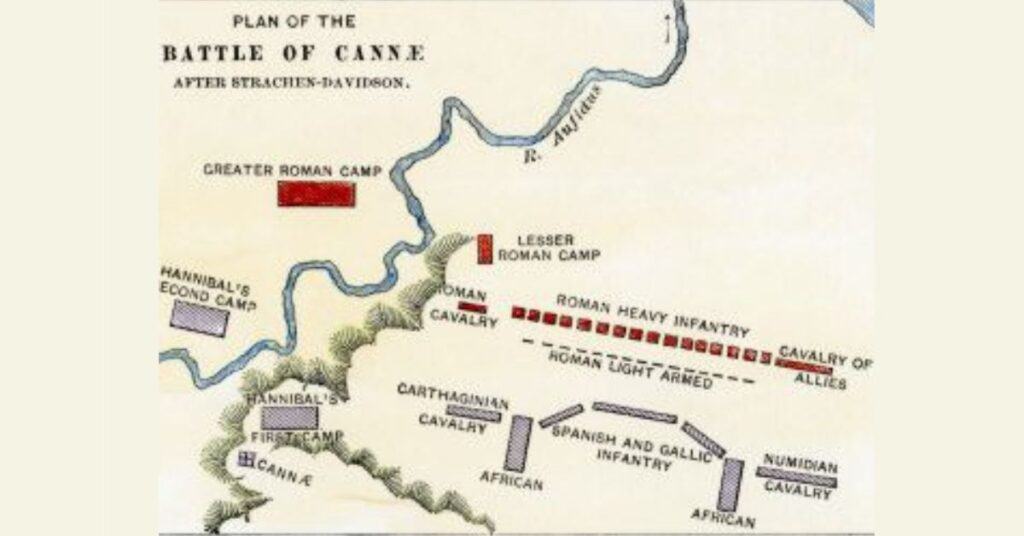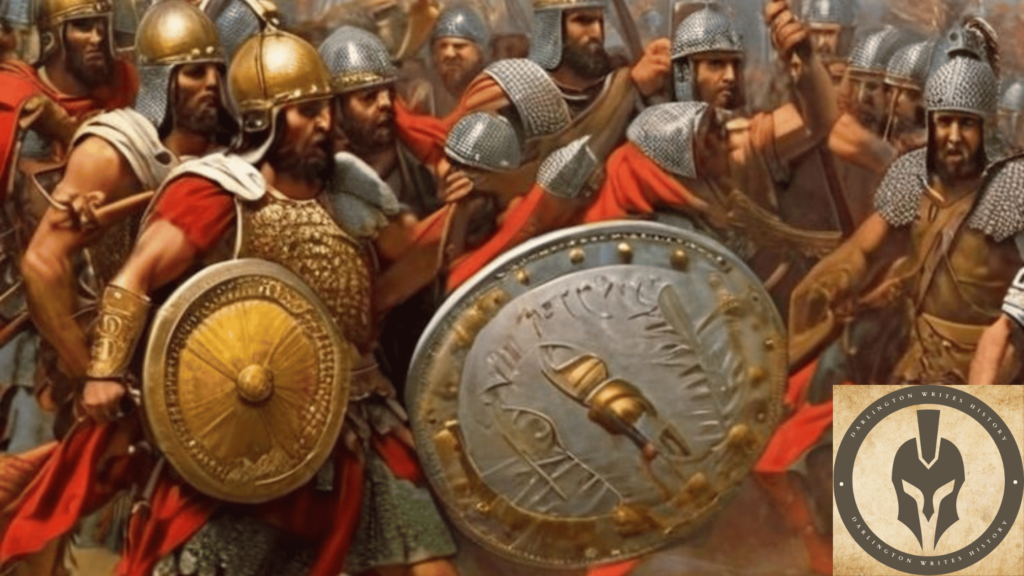What if I told you there was a battle where an entire army was swallowed whole, leaving almost no survivors? Welcome to the battle of Cannae. In a single day, an entire Roman army was nearly wiped off the map.
Fought on August 2, 216 BC, the Battle of Cannae is often remembered as one of the bloodiest encounters in ancient history. This clash between Rome and Carthage during the Second Punic War saw Hannibal Barca execute a military strategy so devastating that it has been studied for centuries. The sheer scale of the carnage left an indelible mark on history and reshaped military tactics forever.
Here, we’ll explore the key events of the battle, Hannibal’s brilliant strategies, and the staggering loss of life that occurred on that fateful day. Prepare to delve into one of the most infamous battles ever recorded.
Background
The Second Punic War
The Second Punic War was a colossal struggle between two powerful empires: Rome and Carthage. This conflict, which lasted from 218 to 201 BC, was the second major clash between these rivals. Their animosity had deep roots, stemming from their fight over control of the Mediterranean. Rome, seeking to expand its influence, clashed with Carthage, a maritime powerhouse determined to defend its territory. Tensions escalated after Rome’s victory in the First Punic War, and it wasn’t long before hostilities resumed. The stage was set for one of history’s most intense wars.
Hannibal vs. Rome
At the heart of this conflict was Hannibal Barca, a brilliant Carthaginian general who had vowed to bring Rome to its knees. In an audacious move, Hannibal led his army, including war elephants, across the treacherous Alps—a feat considered impossible at the time. This journey alone was a testament to his determination and military genius. As he descended into Italy, Hannibal systematically defeated Roman forces, bringing terror to the Republic. His ultimate goal was to strike at the heart of Roman power, and Cannae was the battlefield where he intended to deliver his most devastating blow.
The Lead-Up to the Battle
Hannibal’s Strategy
Hannibal’s campaign leading up to Cannae was a masterclass in strategy. After his daring crossing of the Alps, where he lost nearly half his army to harsh conditions, Hannibal immediately went on the offensive. Despite the losses, he won several key battles, including the Trebia and Lake Trasimene, using cunning tactics that outmaneuvered larger Roman forces. His ability to adapt and exploit Roman weaknesses left his enemies reeling. By the time he reached Cannae, Hannibal had already established himself as a formidable opponent. His strategy for Cannae was simple yet brilliant: lure the Roman army into a trap by offering them a seemingly vulnerable Carthaginian center. He planned to encircle and annihilate them.
Rome’s Response
The Roman Senate, frustrated by their defeats, decided to confront Hannibal with overwhelming force. They assembled an army of over 80,000 men, the largest Rome had ever fielded. Confident in their superior numbers, the Romans believed they could crush Hannibal through sheer might. They placed their faith in traditional frontal assaults, aiming to use their vast infantry to break through the Carthaginian lines. However, their strategy underestimated Hannibal’s tactical brilliance. The Roman commanders, Varro and Paullus, intended to end the Carthaginian threat once and for all, but their overconfidence would lead them straight into Hannibal’s trap at Cannae.
The Battle of Cannae
Deployment of Forces

The Battle of Cannae took place on a wide, flat plain in southern Italy, ideal for large-scale maneuvers. Hannibal chose this location with care, knowing it would allow him to fully exploit his tactical plan. On one side stood the Roman army, nearly 80,000 strong, arrayed in a dense, deep formation designed to break through the enemy center by sheer force. Their infantry, the heart of the Roman military, positioned themselves in tightly packed lines. The Roman cavalry, weaker in numbers, guarded the flanks.
Opposite them, Hannibal’s Carthaginian forces, numbering around 50,000, deployed in a more flexible arrangement. At the center of his line, Hannibal placed his Iberian and Gallic infantry, forming a shallow crescent that bulged outward toward the Roman army. This was the bait—a seemingly weak center that the Romans would eagerly charge. On the flanks, Hannibal stationed his African infantry, highly disciplined and battle-hardened soldiers who would play a critical role. His cavalry, superior in both training and leadership, deployed on the wings, ready to strike at the right moment.
The Carthaginian cavalry on the right, under Hanno, had the specific task of holding the Roman left cavalry in check, preventing them from breaking through or flanking Hannibal’s forces. On the left, commanded by Hasdrubal, the Carthaginian cavalry had the critical role of pursuing and driving off Paullus and the Roman right. Hasdrubal’s cavalry would eventually sweep around to strike at the remaining Roman forces, cutting off their escape and sealing the fate of the trapped legions.
Hannibal’s formation aimed to lure the Romans into overcommitting to an attack on his center, setting the stage for a devastating counterattack. The unique crescent shape was not just a defensive measure—it was a trap that would soon close around the Roman legions with deadly precision.
The Encirclement
The battle began with the Romans charging confidently into the Carthaginian center, driven by their numerical superiority. Hannibal’s troops, arranged in a crescent shape, initially appeared to fall back, creating the illusion of a potential Roman victory. This retreat was a carefully orchestrated move designed to draw the Romans deeper into a trap.
As the Roman forces pushed further into the Carthaginian lines, their own formations became stretched thin and increasingly vulnerable on the flanks. Hannibal’s light infantry fell back strategically, widening the gap and drawing the Romans even deeper into the crescent. Meanwhile, the Carthaginian African infantry, stationed on the flanks, held their ground firmly, prepared to withstand any Roman assault.
At a crucial moment, Hannibal’s cavalry, led by his brother Hasdrubal, launched a decisive attack on Varro’s left calvary. The Roman cavalry quickly routed. Varro fled the field, and Hannibal’s forces then pivoted to strike at the rear of the Roman army. This maneuver cut off any chance of escape or reinforcement for the Romans.
With the Roman cavalry defeated and their center deep within the crescent, Hannibal signaled his troops to close the encirclement. The Carthaginian forces tightened their grip from all sides, fully surrounding the Roman legions. Trapped and with no room to maneuver, the Romans were subjected to a relentless and brutal assault.
The double envelopment, where Hannibal’s forces surrounded the Romans on both flanks and from the rear, proved devastating. The encirclement was complete, and the Roman army was overwhelmed, leading to one of the most catastrophic defeats in military history.
The Carnage
The Battle of Cannae was marked by relentless and brutal fighting. Once Hannibal’s forces completed the encirclement, the Romans found themselves trapped in a nightmarish scenario.
Brutal Fighting
The Roman soldiers, packed tightly within the encirclement, found themselves in a relentless onslaught. With no space to maneuver, they fought shoulder to shoulder, unable to retreat or reorganize. Hannibal’s troops, well-trained and experienced, attacked from all sides. The Carthaginian infantry, skilled in close-quarters combat, pressed in from the flanks and rear, while the cavalry, having routed their Roman counterparts, harassed and struck from behind. The confined space and unrelenting pressure turned the battlefield into a slaughterhouse.
Collapse of the Roman Forces
As the fighting intensified, the Roman formations disintegrated. The soldiers, exhausted and demoralized, struggled to fend off the surrounding enemies. The Carthaginian forces exploited every gap and weakness, maintaining their assault with precision. Centurions lost control of their men in the confusion. The Roman army, once a powerful and disciplined force, was now a disorganized mass of men fighting for their lives. The lack of a cohesive defense and the sheer numbers of attackers led to a swift and overwhelming collapse.
Staggering Number of Casualties
The carnage was staggering. Estimates suggest that around 70,000 of the 80,000 Roman soldiers died, making it one of the bloodiest battles in ancient history. The loss was catastrophic for Rome, both in terms of manpower and morale. The battlefield was strewn with corpses, a grim testament to the ferocity of the conflict. Only a few thousand Romans managed to escape, and those who did recounted the horrors of Cannae.
The sheer scale of the slaughter at Cannae sent shockwaves through Rome and beyond. It was a devastating blow that highlighted the vulnerability of even the most powerful armies and solidified Hannibal’s reputation as one of history’s greatest military tacticians.
Aftermath and Impact
Rome’s Losses
The aftermath of the Battle of Cannae was devastating for Rome. The Roman army, which had numbered around 80,000 men, suffered staggering casualties. Estimates suggest that up to 70,000 soldiers were killed in the battle, nearly annihilating one of Rome’s largest and most formidable military forces. The scale of the loss was unprecedented, leaving Rome reeling from the sheer magnitude of the defeat. The survivors were few and scattered, their morale shattered by the catastrophic scale of the slaughter.
Hannibal’s Victory
Despite Hannibal’s monumental victory, the battle did not lead to the downfall of Rome. While Cannae was a tactical triumph, it lacked strategic follow-up. Hannibal’s forces, though victorious, were significantly weakened by the battle. The Romans, though devastated, were able to recover and adapt their strategies. Rome’s resilience was formidable; they adopted new military tactics and restructured their armies. Additionally, Hannibal’s lack of resources and reinforcements, combined with logistical challenges, prevented him from capitalizing fully on his victory. Rome, through persistent efforts and strategic adaptations, managed to endure and eventually turn the tide of the war.
Long-Term Impact
The Battle of Cannae left a lasting mark on military strategy and history. The double envelopment tactic employed by Hannibal became a classic example of battlefield strategy and is studied in military academies to this day. The battle demonstrated the effectiveness of superior tactics over numerical advantage, influencing future military leaders. It also highlighted the importance of flexibility and innovation in warfare. Cannae’s legacy endures as a case study in both strategic brilliance and the limits of even the most successful military victories. The lessons from Cannae continue to shape military thought and strategy centuries after the battle.
Conclusion
The Battle of Cannae stands out as one of the most devastating conflicts in military history. The sheer scale of the bloodshed, with up to 70,000 Roman soldiers perishing in a single day, underscores the brutal nature of ancient warfare. Hannibal’s tactical genius, demonstrated through the double envelopment, remains a defining moment in military strategy. This battle not only reshaped the course of the Second Punic War and left an indelible mark on the study of warfare.
Cannae serves as a powerful lesson in the art of strategy and leadership. Hannibal’s ability to turn the tide with superior tactics and the Romans’ subsequent recovery illustrate the unpredictable nature of warfare. The battle exemplifies how even the most significant victories can have limits and how resilience and adaptation can turn the course of history. It’s a reminder that in war, strategy and flexibility often outweigh raw numbers and brute force.
For those fascinated by ancient warfare, exploring further battles and strategies can provide deeper insights into military history. Consider delving into other pivotal conflicts, such as the Battle of Gaugamela or the Siege of Syracuse, to see how different leaders faced their challenges. Each battle offers unique lessons and perspectives that continue to captivate and educate those interested in the art of war.

